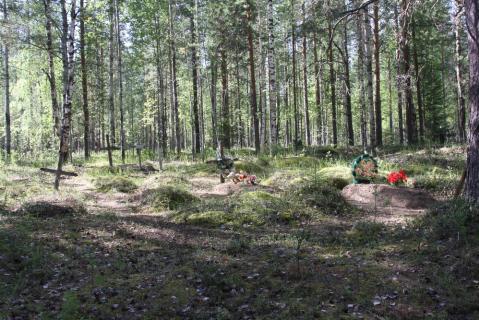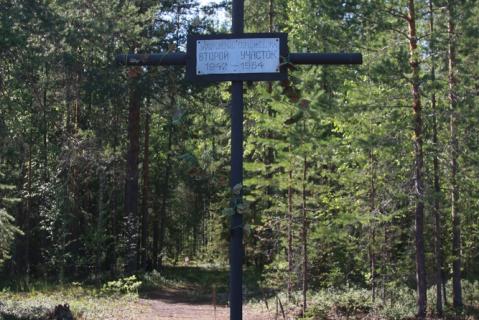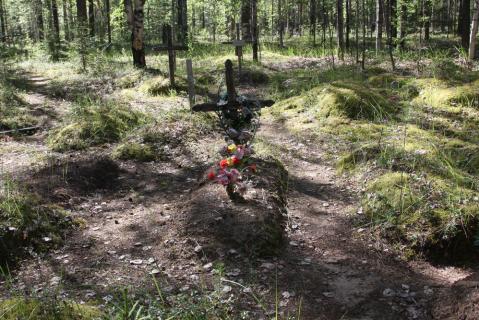The settlement on the Kiyayu river arose in the early 1930s. The first to arrive were dekulakised peasant families; then it became a subdivision of Lokchimlag. In 1941-1956 it was known as the Second Section of the Kortkeros forestry concern. From 1941 onwards Lithuanians, Poles, Soviet Germans and those serving terms of imprisonment were attached to the forestry works until the end of the war (they included Finns, Chinese, Koreans and Iranians). Those who died were buried in the coniferous forest about one kilometre from the settlement.
By the early 2000s several dozen burial mounds with fallen crosses had survived. The numbers buried there has not been established. In 2001 a local history expedition of the Kortkeross Centre for Schoolchildren’s Extracurricular Education led by A.A. Smilingis studied the graveyard, drew up a plan of the burials and tidied part of the area. In June 2001 a memorial cross was erected and consecrated at the site, bearing the inscription, “Burials of the Second Section special settlement, 1942-1964”.
The Memorial online database (2025) lists 129,473 victims in the Komi Republic. (See Nizhny Chov.)
Among them were over 64,000 deportees sent to or born in the Republic. During collectivisation (1929-35) they numbered 20,366, a quarter of whom were aged 1-10. In 1940 there was a massive influx from occupied Polish territory (19,367). More, mainly Germans (5,970) were sent in the 1940s and 1950s (6,699).
The database names 3,653 individuals who were deported to the Kortkeross district, many as dekulakised families, or later born there (295). It lists 458 sent to Kortkeross village in 1941, many from occupied Polish territory.
| Date | Nature of ceremonies | Organiser or responsible person | Participants | Frequency |
|---|---|---|---|---|
|
14 June
|
Day in Remembrance of the Deportation of the Nations of the Baltic States
|
nk
|
Former settlers and their descendants, local historians, schoolchildren, Syktyvkar NGOs
|
Annual event
|
| State of burials | Area | Boundaries |
|---|---|---|
|
subsidence over burials; some burial mounds with fallen crosses have survived
|
not determined
|
not delineated
|
[ original texts and hyperlinks ]
2001 local history expedition by the Kortkeross Centre for Schoolchildren’s Extracurricular Education – Archive of the Pokayanie Foundation (Syktyvkar)
“Kortkeross village. Deportees graveyard”, Virtual Museum of the Gulag [retrieved, 26 May 2022; no longer accessible]



